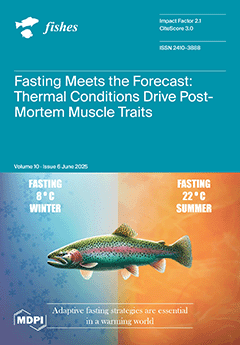Essential fatty acids are extremely important nutrients in the diet of fish, and the balance between arachidonic acid (ARA) and eicosapentaenoic acid (EPA) is crucial for the healthy growth of fish. Six isonitrogenous and isolipidic basal diets were given to 540 juvenile fat greenling (
Hexagrammos otakii) (31.4 ± 1.5 g) for 8 weeks to investigate the effects of dietary ARA/EPA ratio on growth performance, antioxidant capacity and lipid metabolism-related genes of juvenile
H. otakii. The control group (A) had 7% fish oil added as the main fat source, while the experimental groups had 4% fish oil as the basic fat source, with varying proportions of ARA and EPA concentrates added to formulate five diets with varying ARA/EPA ratios (B 2.66; C 1.34; D 1.01; E 0.47; F 0.19). The experimental results revealed that adding ARA and EPA to the diet increased the percent weight gain (PWG) and feed conversion ratio (FCR) of juvenile
H. otakii, and the PWG and FCR were greatest under Group E dietary conditions. The specific activities (U/mg protein) of superoxide dismutase (SOD), catalase (CAT), and total antioxidant capacity (T-AOC) in the liver, as well as serum SOD and CAT were significantly higher in Groups D and E than those in other groups (
p < 0.05). Malondialdehyde (MDA, nmol/g protein) content in the liver and serum was significantly lower in Group E than that in other groups (
p < 0.05). Moreover, groups D and E exhibited significant increases in the specific activities (U/mg protein) of intestinal trypsin, lipase, and amylase, as well as in the intestinal villus length (
p < 0.05). The incorporation of ARA and EPA into the feed reduced the expression levels of fat synthesis genes such as
fas,
scd1,
accα, and
srebp1, as well as the expression of lipolysis genes
atgl and
hsl. However, it also increased the expression of the lipolytic genes
cpt1 and
ppara. The ARA/EPA ratios in the dietary were 0.47 and 1.01, respectively, which are appropriate for enhancing growth efficiency, antioxidant enzyme activity, intestinal digestive enzyme activity and lipid metabolism regulation.
Full article





